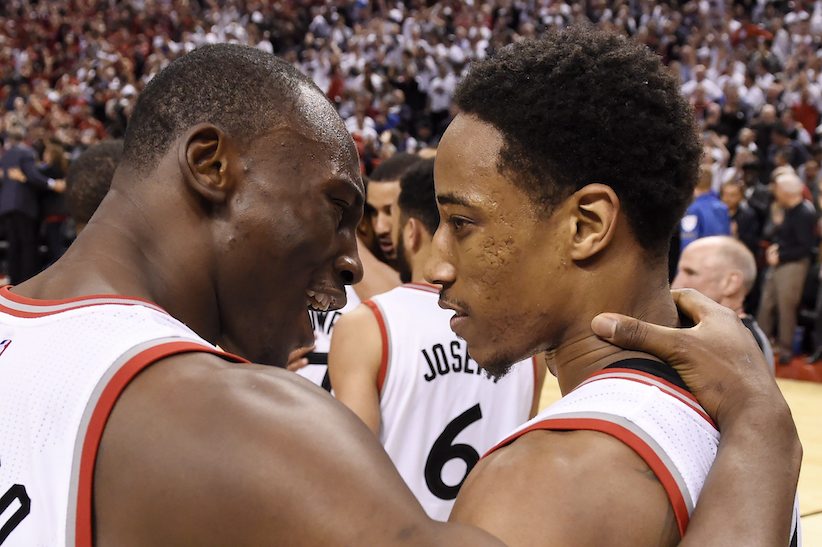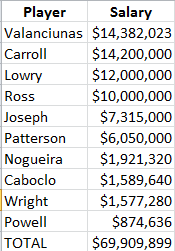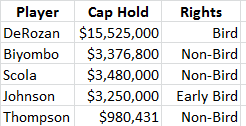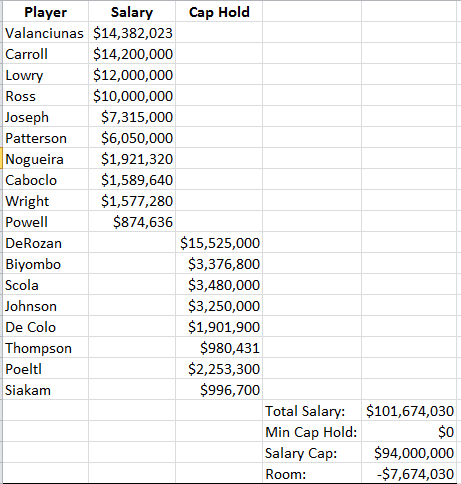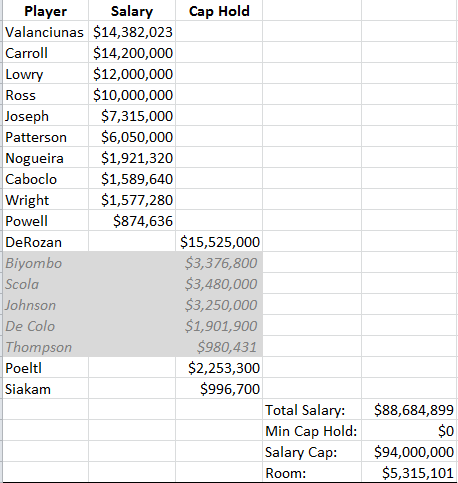While everyone else is getting ready for their Canada Day (or July 4) long weekend, the basketball world will be at the starting line of the 2016-17 season, champing at the bit to strike first in free agency, leverage the new wheelbarrows full of cap space, and ultimately change the landscape of the NBA in short order. Free agency begins at the stroke of midnight late Thursday/early Friday, and with it we enter a pretty strange new frontier: The New TV Money Era, where a ludicrous national rights deal will push the NBA’s salary cap from $70 million to $94 million, based on the latest reports.
That would seem to leave the Toronto Raptors in a good position – they spent far less than their semi-final compatriots in terms of 2015-16 salary, have a strong, young asset base to supplement the roster on the cheap, and have greatly improved their desirability as an organizational destination (shout out to Masai Ujiri).
Unfortunately, the cap boom is happening at a time at which the Raptors really can’t make the most of it. Because extensions for Terrence Ross and Jonas Valanciunas kick in and because they don’t own the (full) rights to their second-most important free agent, they’re actually in a situation where financial flexibility is limited. There are means of clearing cap space to retain Bismack Biyombo or becoming a player in free agency, but either would require some careful salary gap gymnastics. Luckily, the Raptors’ front office is well-staffed to execute such machinations (we see you, Bobby Webster).
What follows is an explanation of the contract situations and cap rules that the Raptors face right now. This is the third year in a row I’ve done this post in the hopes of helping readers understand why certain moves can or can not happen, and how they may come to pass. Some of it will be in less detail than is necessary for a thorough understanding and some of it will be in more detail than is necessary for a cursory understanding (apologies if I haven’t correctly navigated that middle-ground) – if you have any questions, tweet them to me @BlakeMurphyODC or email them to me at eblakemurphy1@gmail.com, and I’ll do a follow-up post explaining certain rules or scenarios.
Note: All salary and cap data comes courtesy of Basketball Insiders or my own calculations based on information from CBAFAQ.com and publicly available cap estimates, where applicable. Also, a thanks to Daniel Hackett and Anthony Doyle for error-checking the post.
Contracts, holds, and explanations
Contracts
The Raptors have the following contracts on their books for 2016-17:
Note that because the league year changes on July 1, Ross and Valanciunas are no longer subject to the “Poison Pill Provision” that made trade scenarios involving them so difficult during the season. All of these contracts are guaranteed and are fully available to be used in trade.
Unrestricted Free Agents
The Raptors have the following unrestricted free agents, with their cap holds and rights types highlighted:
Having those expiring contracts doesn’t necessarily give the Raptors cap space. Until the rights to those players are renounced, the players have cap holds, which count for the purposes of the salary cap to prevent teams from signing a bunch of free agents with cap space and then signing their own guys. In many cases, ordering signings in that way can still be beneficial (which is why in many scenarios, it will make sense for the Raptors to wait to re-sign DeRozan to prevent his cap hold from increasing), but for the Raptors, they may need to renounce some rights to clear up space.
That’s especially true for Biyombo, Scola, and Thompson, as the Raptors only have non-Bird rights on each. Full Bird rights (like DeRozan’s) allow a team to exceed the salary cap to re-sign their own player up to the maximum contract. Early Bird rights allow a team to exceed the cap to re-sign their own player up to 175 percent of their previous salary or a 4.5-percent increase on the league’s average salary (estimated at $5.74 million last year) from the year prior, on a deal of at least two years in length (so they could give Johnson a raise, so long as they were willing to give him a two-year deal; otherwise, they can renounce his Early Bird rights and re-sign him to a one-year deal with Non-Bird rights).
Non-Bird rights only let a team exceed the cap to re-sign a player up to 120 percent of their previous salary (which is why the team can’t exceed the cap to pay Biyombo what he’s earned).
Each of these cap holds exist until the Raptors renounce their rights or they sign new deals. In reality, the team will only renounce rights once they require the cap space doing so creates, but it’s fair to just consider the cap holds of Biyombo, Scola, Johnson, and Thompson gone for the purposes of concocting offseason scenarios.
Restricted Free Agents
The Raptors have the following restricted free agents, with their cap holds highlighted:
![]()
Yes, that Nando De Colo. The Raptors still own his rights in restricted free agency (and his Early Bird rights), even though he just signed another multi-year deal with CSKA Moscow. If the Raptors want to retain his RFA rights, they’ll need to issue him a $1.83-million qualifying offer by June 30, one that will stay on the books all summer (note that I used his cap hold amount rather than his $1.83-million qualifying offer) unless the Raptors rescind his rights.
This is mostly just a bookkeeping note – De Colo isn’t coming over, but if their offseason maneuvering allows, the Raptors may be able to maintain his rights and keep him on the books through the summer. The second they need that space, though, they’ll ditch on his rights.
Non-guaranteed Deals
The Raptors do not have any players on non-guaranteed deals.
Also off the Books
The small guarantees paid to Ronald Roberts, Axel Toupane, Michale Kyser, and Shannon Scott are off the books, as is Anthony Bennett.
Draft picks
The Raptors have the following first-round draft picks, with their cap holds highlighted:
Picks almost always sign for 120 percent of scale, but until the contract is signed, only the scale amount for the pick counts on the books. Like with DeRozan, the Raptors can give themselves an additional bit of flexibility by waiting to officially sign these picks. The drawback there is that once signed, the picks can’t be traded for 30 days, so it may make sense to lose that shred of cap space to expedite the option to trade either rookie.
The big picture
Here’s how the Raptors’ cap sheet looks at present:
The team is going to look nothing like that, of course. For the purposes of planning your offseason moves, it’s probably best to assume the rights to all free agents except DeRozan are renounced. The sheet would then look like this:
That’s essentially what the Raptors are working with right now. Ten players under contract, two draft picks, and the rights to DeRozan, plus $5.3 million in cap space.
Exceptions
There are sometimes scenarios in which it makes sense for a team to stay above the cap. If the Raptors opt to do so (either by signing DeRozan immediately or not renouncing the rights to free agents), they open themselves up to the non-taxpayer mid-level exception. They would also have the bi-annual exception in that case. If the Raptors duck below the cap at any point, they’ll instead have only that cap space and the room mid-level exception.
Get under cap
If the Raptors go under the cap as outlined, they’ll have the following:
Cap space: $5,315,101
Room mid-level exception: $2,898,000 (one- or two-year deals with a 4.5-percent raise; can be split between players)
Stay above cap
If the Raptors stay over the cap as outlined, they’ll have the following:
Cap space: $0
Non-taxpayer mid-level exception: $5,628,000 (up to a four-year deal, with raises of 4.5 percent of the first-year salary; can be split between players)
Bi-annual exception: $2,203,000 (one- or two-year deals with a 4.5-percent raise; can’t be used two years in a row; can be split between players)
As a note, these exceptions are only available so long as they won’t push a team over the “apron,” which is $4 million above the luxury tax. It would also create a hard-cap for the Raptors at the apron. The Raptors would have to have a pretty crazy offseason to get into the tax (projected to be $113 million, with a $117-million apron), so that’s more of a back-of-the-mind thing
In either case, the Raptors would also have the minimum player salary exception, which allows you to exceed the cap to sign players on veteran minimum deals.
Trade Exceptions
The Raptors have no available trade exceptions. They had some active ones last season but they disappeared when the team went below the cap.
Assets
Picks
The Raptors own all of their own future first- and second-round draft picks and also own a lottery-protected 2017 first-round pick from the Clippers (via the Bucks).
Draft Rights
The Raptors own the draft rights to DeAndre Daniels, who should be slated for the D-League this season. He’s more or less lost the bulk of the last two years to injury, playing well in Australia and then sparingly stateside due to a Jones fracture (his Australian time was also cut short by eye and elbow issues). If the team hopes to play him in the D-League once again, on a $25,500 D-League max contract rather than as an NBA player on assignment, Daniels will have to agree. If he doesn’t, and he wants to try his hand in the NBA, the Raptors have to offer him at least a non-guaranteed minimum contract to retain his rights, and Daniels could roll the dice on signing that (he’d then come to camp and, if cut, become an unrestricted free agent).
The Raptors also own the draft rights to DeeAndre Hulett (2000). Hulett was never anything more than a footnote – while these rights mean little, they also cost little, and in the event the Raptors wanted to acquire someone for nothing (think Luke Ridnour for Tomislav Zubcic last summer), these rights can be used as “consideration” (both teams need to send something to the other in a deal).
Cash
The league allows teams to send out and receive up to $3.5 million in a season. The Raptors have sent and received $0, so those full amounts are available to them.
Wrap
That’s a lot to sort through. The front office doesn’t have an easy job, and putting this together is a stressful endeavor because I know there are a handful of fans out there who will want even more detail/explanation and some who thought this was too in-depth for what a general fan needs. This is meant to be a pretty high-level preview of what the Raptors are working with entering the offseason, and I’ll do my best to nail a salary cap situation down to the penny once free agency is set to open and we know the exact cap/tax/max numbers.
The key points you need to know:
- There is a ton of money chasing a weaker free agent class, creating a great deal of uncertainty and, surely, contracts that will eventually make us gasp. It may not be the worst year to be sitting out free agency.
- The Raptors stand to have a little bit of salary cap space, if they want it, but may be better off staying above the cap and using exceptions. That’s tough to figure without knowing how this insane market will play out.
- The Raptors can get creative by trading players away, so any dream scenario can be on the table, because it’s more fun, anyway.
- DeRozan is likely to stay, but him taking a discount doesn’t impact the situation of Biyombo, because DeRozan’s cap hold is so small already.
- Biyombo is probably gone but the Raptors can get funky if keeping him is a top priority for them.
- I have absolutely no idea what direction Ujiri may go in.
If you have any questions, tweet them to me @BlakeMurphyODC or email them to me at eblakemurphy1@gmail.com, and I’ll do a follow-up post explaining certain rules or scenarios.

